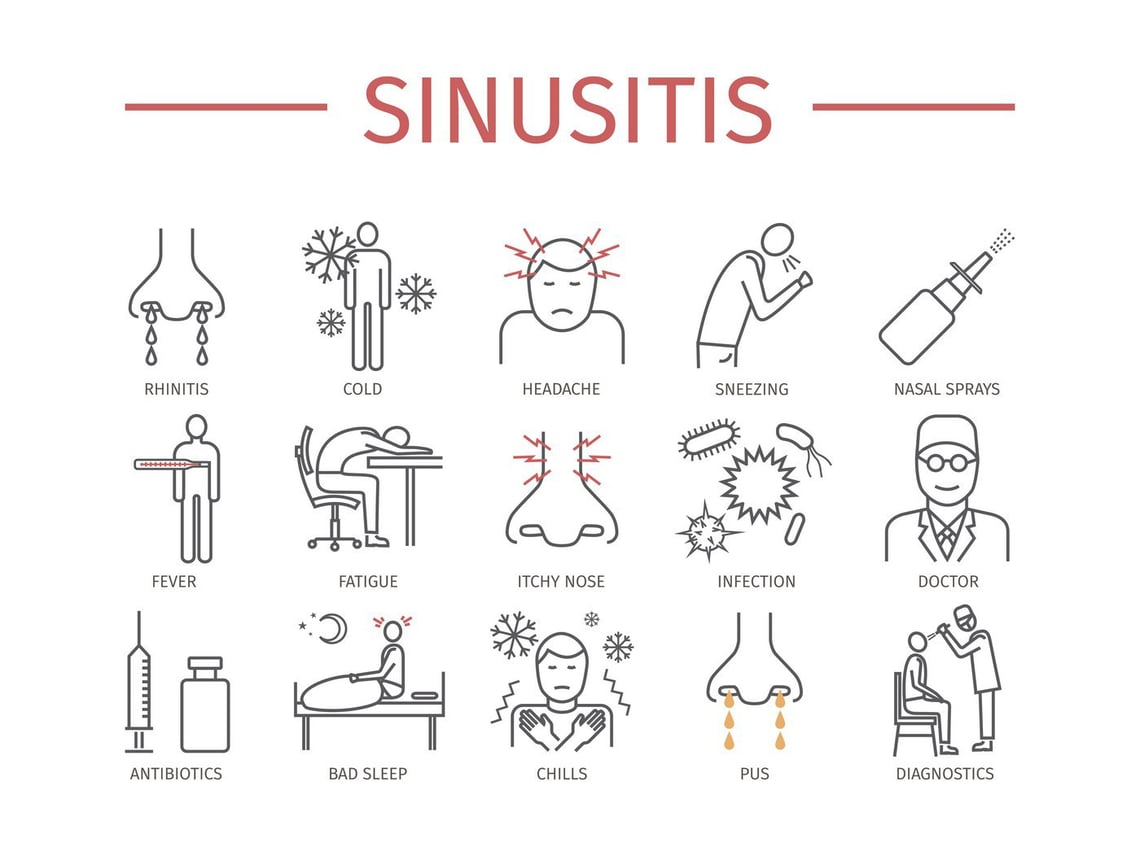Everything Houston Residents Need to Know About Sinusitis Diagnosis
May 17th, 2017 | 4 min. read


Stuffy nose, a cough, facial pain and swelling, with a side dose of headache. Feeling tired and sleepy. All of these symptoms may point to the fact that, while you think you are suffering from allergies in Houston, you are actually a victim of sinusitis.

You may have suffered with your sinuses for months or even years on and off without being aware of your diagnosis. Maybe you chalked it up to allergies from your pet, the weather, or just
an average cold.
Your symptoms could be signs of sinusitis.
If you are wondering if you could have sinusitis, or you have been diagnosed with it already, you most likely have questions about this condition. Let's dive into the signs, types, diagnosis, and treatments of sinusitis.
What is sinusitis?
Sinuses have tissue that line them, and typically a healthy sinus cavity is filled with air. When sinuses are introduced to irritants, the lining becomes inflamed and they can get blocked and fill with fluid. This moist environment is ripe for bacteria to grow and thrive. This infection of the sinuses is known as sinusitis.
What causes sinusitis?
There are multiple factors that can bring on sinusitis.
A deviated septum. The nasal septum is the part of the nose that separates it into each side. This is made of bone and cartilage, and can be easily damaged. If the nasal septum gets unbalanced or crooked, it can block your sinuses from draining properly, and result in a sinus infection. Many people are born with a deviated septum, and others suffer from it as a result of facial trauma. Either way, this is a common cause of the condition, and can tend to make it recur often.
Allergies. Trees and warm weather are your enemy! Houston allergies are notorious for bringing on bouts of sinusitis. With the almost year-round humid, warm temperatures being a paradise for mold growth, and the abundant greenery spiking the pollen count, every other person on the street is probably dealing with allergies! Sinusitis symptoms are frequently mislabeled as allergies, and allergic reactions may aggravate sinusitis. People with allergies tend to wipe their noses and touch their eyes more often than normal, which can also introduce irritants that can set up infection.
Nasal polyps. These benign growths can form inside the nasal tissue and aggravate sinusitis symptoms. The polyps are caused by allergies, asthma, or infection. Once formed, they create a blockage in the nasal cavity that causes fluid to fail to drain, and bring on sinusitis. A person may not realize he or she has nasal polyps until a doctor examination finds them.
An old-fashioned cold. While a cold doesn't directly cause sinusitis, it creates a perfect environment for it to live and grow. As with allergies, if a person has a cold, they typically ripe their runny nose often and touch their itchy, watery eyes. Bacteria from this contact can end up in the nasal cavity, cause inflammation, and BAM, the cold morphs into sinusitis.
What are the signs of sinusitis?
The fact is, you may suffer from Houston allergies, or it may be sinusitis. The symptoms are quite similar. Being a snotty mess is common. Yay! (Sarcasm). A stuffy or runny nose, general
congestion, a sore throat, and a cough are symptoms of both. It's more likely sinusitis if you experience pain across the bridge of your nose or pressure under your eyes, a fever, yellow or green mucous, and ear or dental pain. All of these stem from the blockage and infection in your sinus cavity.
Are There Different Types of Sinusitis?
Depending on the length of time you suffer and whether or not it returns, you could have either acute or chronic sinusitis. If you experience sinusitis symptoms that last around ten days and then you start feeling better, your drainage clears, and your facial pain and pressure dissipate, you have acute sinusitis. If, unfortunately, you deal with it for more than twelve weeks, or it comes back one or more times within the next year, chronic sinusitis is the problem.
How Does A Doctor Arrive at A Sinusitis Diagnosis?

If you thought you had Houston allergies, but over-the-counter medication doesn't help, and your symptoms linger, it's time to make an appointment and see your physician. During a
doctor's appointment, the examination for signs of sinusitis may include a look into your nasal passages, an examination of your nasal discharge, your eyes, and cheeks.
In some cases, you may also need X-rays, a CT scan, an MRI, an ultrasound, and other tests that would determine exactly what is causing your symptoms. Based on what the doctor finds, the symptoms you describe, and the length of time the symptoms have been present, he or she may give you either an acute or chronic sinusitis diagnosis.
How Is It Treated?
The good news is that sinusitis symptoms are quite easily treatable and usually responsive within a few days. They depend in part on what is causing the sinusitis in the first place.
The doctor may prescribe saline nasal washes that you can do regularly at home. This process cleans out the sinus cavity and helps the body get rid of the infection. You may also need to take decongestants and antihistamines, especially if you are also suffering from those common Houston allergies.
The doctor may or may not prescribe a round of antibiotics.
If you have a deviated septum and deal with chronic sinusitis, the doctor may recommend surgery to correct the problem.
If nasal polyps are the cause, a surgical procedure, typically done as an outpatient procedure, to remove those may be in order.
In addition, there are a few ways at home to combat the symptoms of sinusitis. Warm compresses on your face can reduce inflammation and ease the pain from swollen sinuses. Using a vaporizer, especially at night, can also assist in alleviating the symptoms.
For chronic sinusitis sufferers, Balloon Sinuplasty is also an option. During Balloon Sinuplasty, the Doctor provides a local anesthetic and locates the areas identified in your diagnosis. A small, flexible, balloon catheter is inserted into the nose, and into the sinus openings. When the balloon on the catheter is inflated, it gently restructures and widens the sinus pathway. With the pathway enlarged (dilated), the sinus can once again drain properly. The procedure is quick and typically requires about 30 minutes with the Physician.
You cab get the jump on an attack by not smoking and avoiding smoky places. If allergies in Houston bring it on, take your meds regularly and avoid being around things that make them act up. Always practice good hygiene by keeping your hands washed and clean, and touch your face and nose as little as possible.
Whether it's Houston allergies or a cold, a deviated septum, or nasal polyps that cause infection in your sinuses, it's important to proactively address the root issue of the condition. Visit you doctor for treatment, and if you receive a sinusitis diagnosis, follow his or her instructions to the letter. Doing so will help you get over it sooner, and lessen the chance of it becoming worse.
If you or a loved are suffering from symptoms suggestive of Sinusitis, please contact Houston ENT today. We have 12 locations throughout the Houston area. Call us at (281) 649-7000 to schedule an appointment.
Click the eBook below to get your FREE eBook today for more information on Sinus Infections, Allergies, Sinusitis and the Balloon Sinuplasty.
Dr. Suchanova is a Diplomate of the American Board of Otolaryngology Head and Neck Surgery and a Fellow of the American Academy of Otolaryngology Head and Neck Surgery. She is fluent in English, Czech, Slovak and conversational in Spanish.
Topics:

